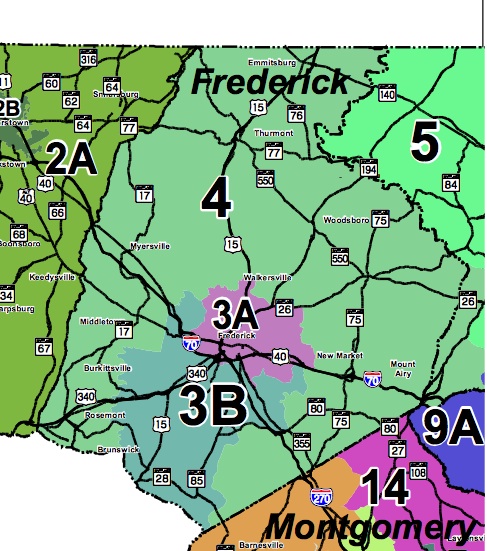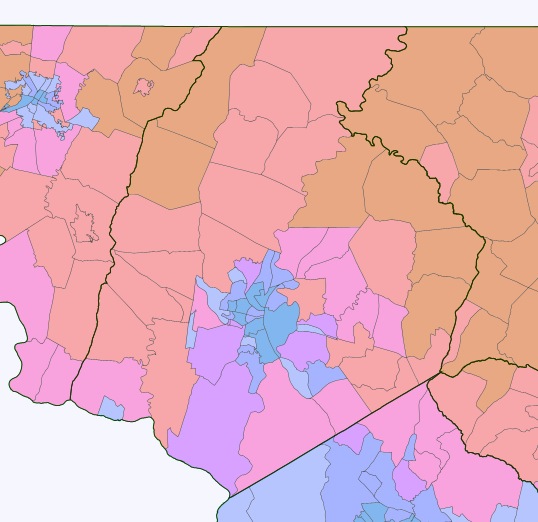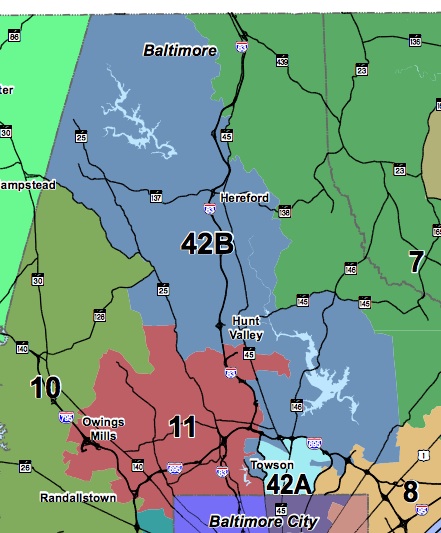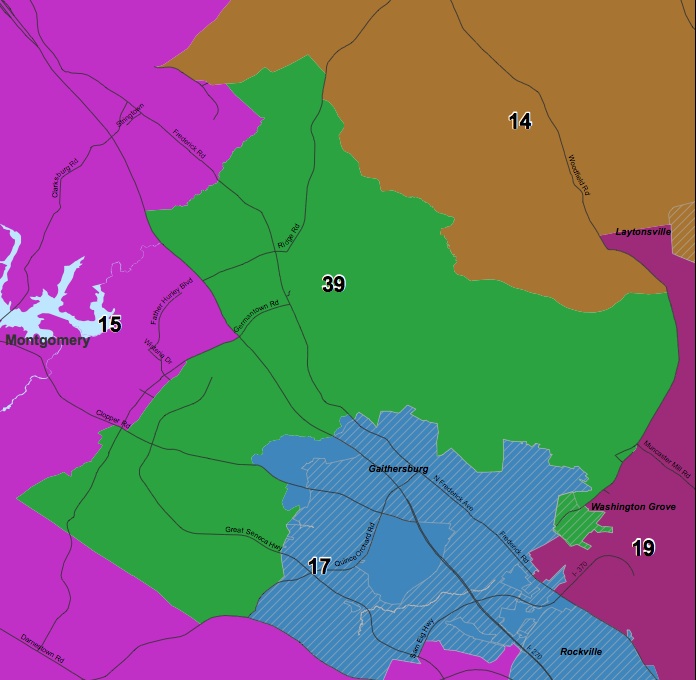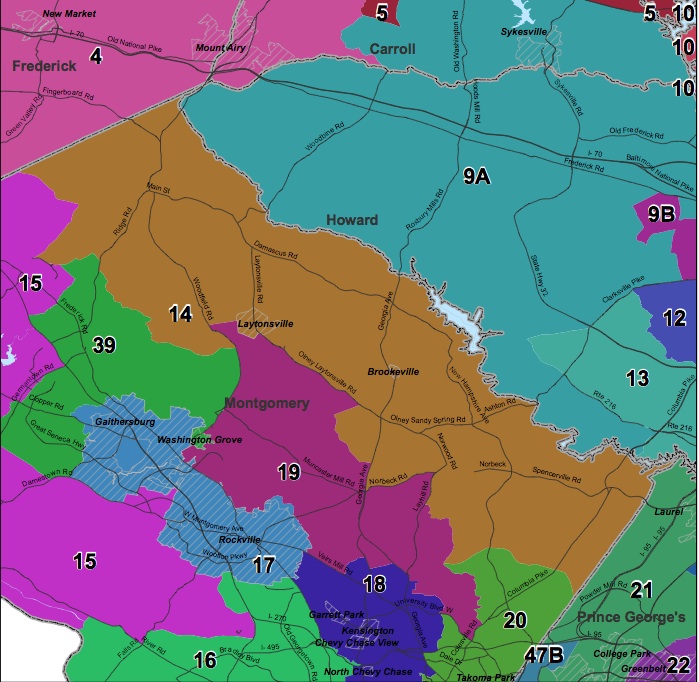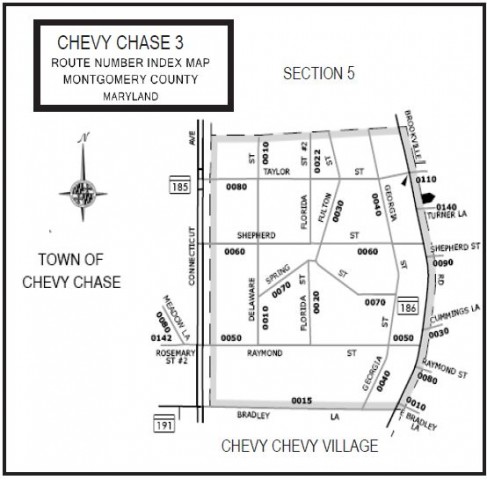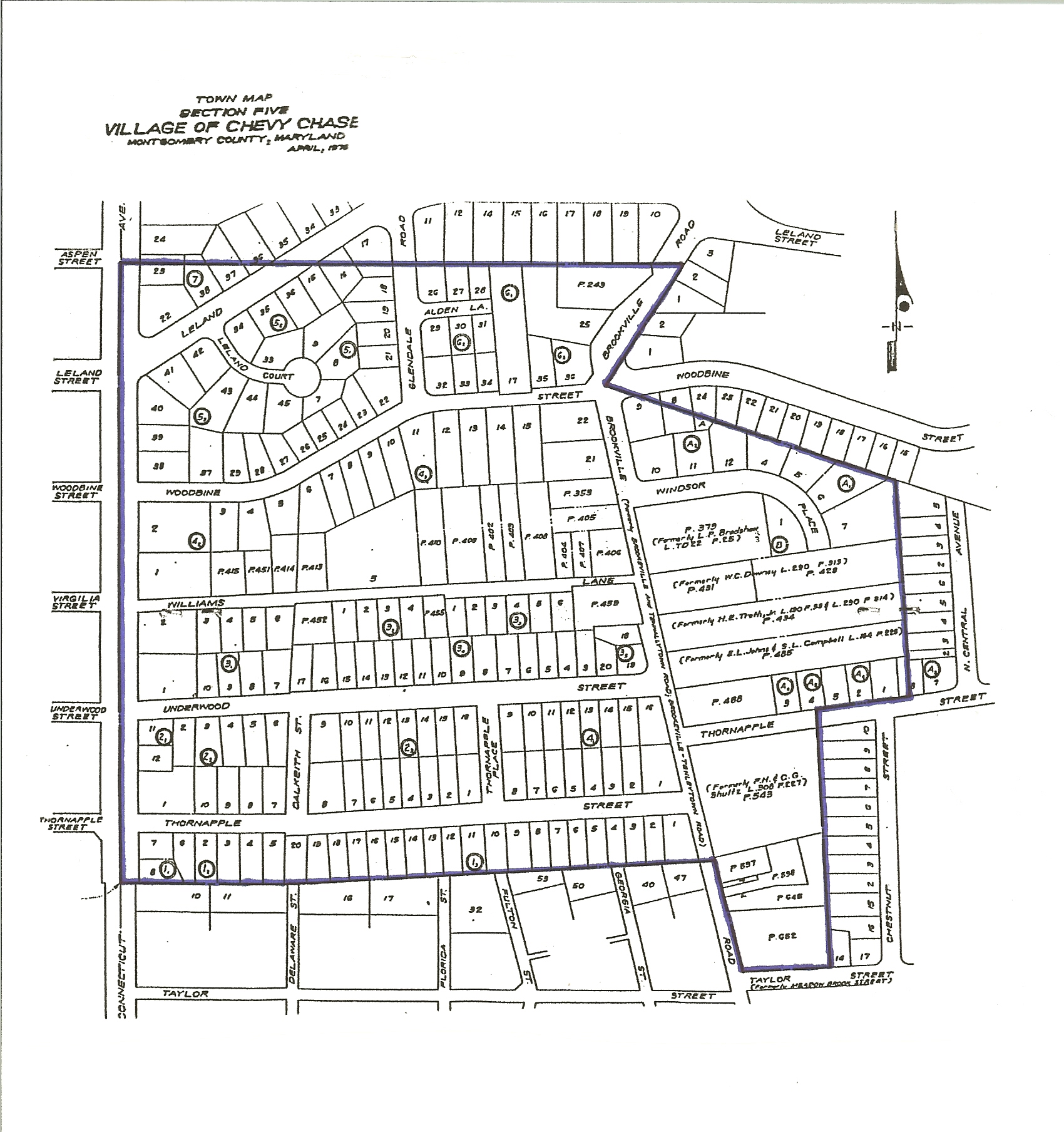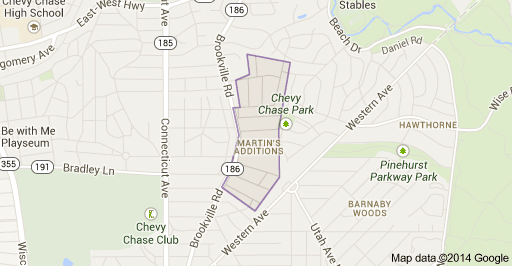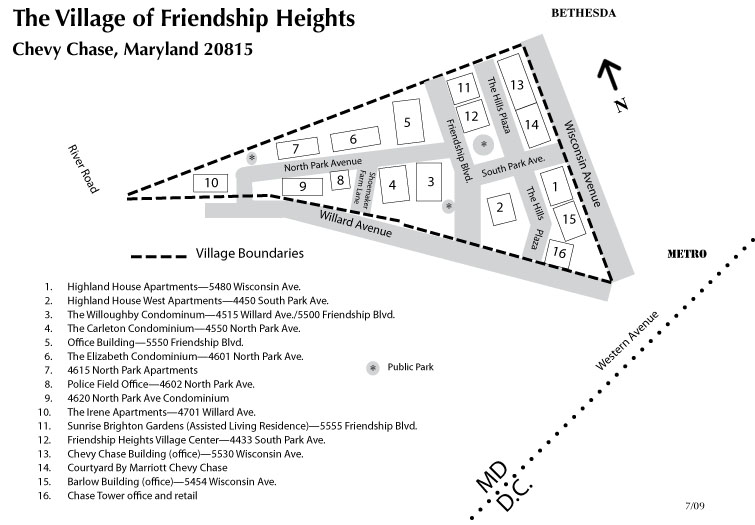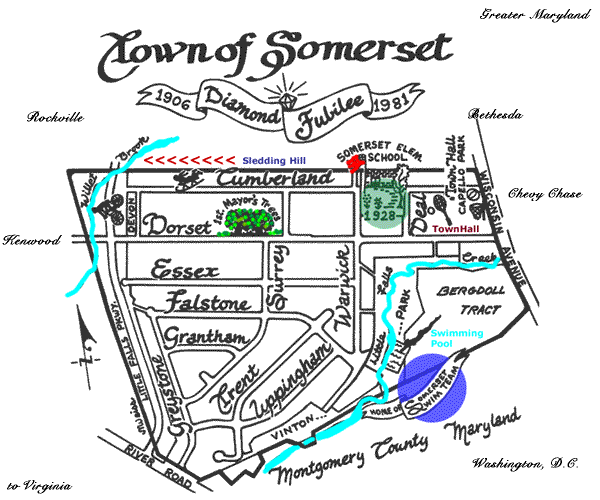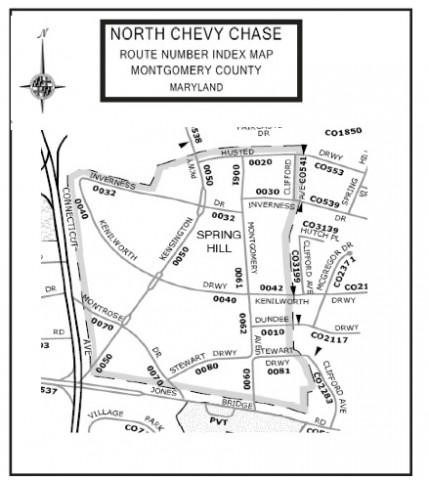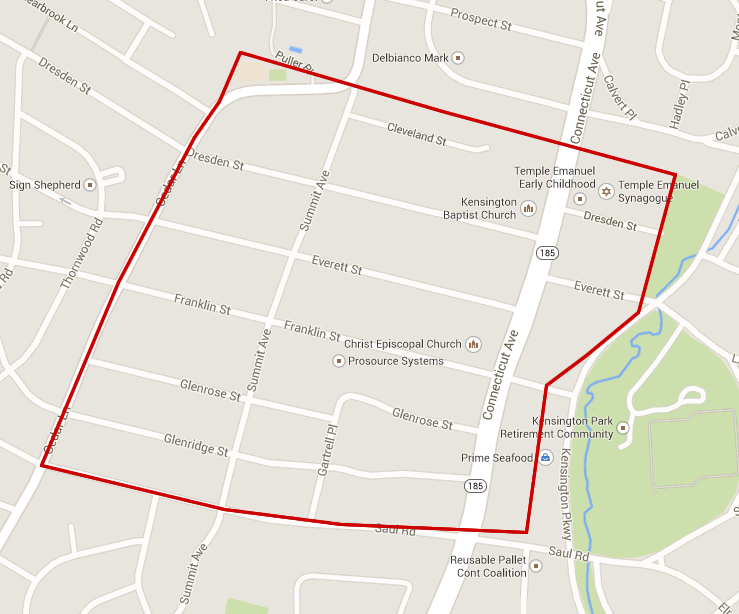UPDATE: The Quinton Report says that Del. Michael Hough is telling Sen. David Brinkley that he is going to challenge him tomorrow. This one will be bloody. For more info, see the post earlier today on the political lay of the land in Frederick County.
Monthly Archives: February 2014
PSC Nominee Approved
UPDATE: Controversial Public Services Commission Nominee Anne Hoskins was approved by the Senate Executive Nominations Committee last night. h/t Center Maryland.
Two Fredericks: D3 and D4
In the not too distant past, Republicans looked at counties like Frederick and got excited. Fast growing exurbs like this and the loss of population in places like Baltimore City would gradually shift Maryland in their direction.
Frederick has indeed grown but disappointed the GOP bitterly by becoming much more Democratic in the process. President Obama received 49% in 2008 and 47% in 2012 of Frederick votes. A marked increase compared to the 39% received by Al Gore in 2000.
Under the old legislative district plan, Frederick had all but a tiny piece of District 3. Frederick and Carroll Counties shared District 4 with 4A located in Frederick electing two delegates. District 4B, situated entirely in Carroll except a small bit around Mt. Airy, elected the remaining delegate.
The 2010 Frederick Districts
Redistricting has been good to Frederick. As shown below, Frederick nearly has all of two full districts under the new plan–less than 10% of District 4 remains in Carroll and its subdistricts have accordingly been eliminated.
The 2014 Frederick Districts
The new districts follow Frederick’s partisan divisions more closely than the old map. As the map below from Dave’s Redistricting shows, District 3 takes in the most Democratic portions–the City of Frederick and areas to the south–with the remaining much more Republican areas in the County composing District 4.
Additionally, Del. Michael Hough’s (R-3B) home was moved to District 4. Altogether, the changes help Democrats as it strengthens their position in swingy District 3. Meanwhile, District 4 remains a little piece of Republican heaven.
Partisan Composition of Frederick (Blue is D and Red is R)
District 3
In District 3, former Frederick Mayor Ron Young toppled shrill right-wing gadlfly Sen. Alex Mooney in 2010. He moved on to running the State GOP into the ground before fleeing to West Virginia for redder pastures where he is now a congressional candidate. Even Maryland Republicans don’t seem to miss him.
Sen. Ron Young has taken liberal stands–he was a strong supporter of marriage equality while Mooney was one of its most vocal opponents–but no one can touch him. He is unopposed in the primary and general election.
All three delegate seats are open. In 3A, neither Del. Patrick Hogan (R) nor Del. Galen Clagett (D) will seek reelection with Hogan’s decision at least partly influenced by the more Democratic version of this Frederick City district. The new redistricting plan placed Del. Michael Hough’s (R-3A) home in District 4.
In District 31A, Sen Ron Young’s wife, Karen Lewis Young has filed for one of the two delegate seats but has not filed a campaign finance report (or at least one doesn’t come up when I search for it). She has a website for her unsuccessful run for the Frederick mayoralty as the Democratic nominee in 2013. In that contest, Young came in second with 32% behind Republican Randy McClement who won with 49%. If elected, Sen. Young and Del. Young would be the only husband and wife team in the General Assembly.
The other potentially strong candidate appears to be Frederick Alderman Carol Krimm. Though she has just $1700 in her campaign account, she has held office and aldermen run citywide, so she is already known throughout a fair portion of the district.
Young and Krimm seems well positioned to win the two seats, if only due to the weakness of the other competition that has filed so far. Candidate Nicholas Bouquet just moved to Frederick one year ago and has also filed no campaign finance report (or again, it just doesn’t appear when I search for it). Roger Wilson has raised no money. The two Republican candidates are poorly funded.
In 3B, Frederick County Democratic Central Committee Vice Chair Stephen Slater is the only filed candidate. Of course, the filing deadline has not yet arrived.
District 4
All four seats in District 4 are safe for the Republicans. Though Del. Michael Hough’s website still solicits support for running in 3B, his home is now in District 4 and plans to run for the Senate against incumbent Sen. Minority Leader David Brinkley. Hough’s very active twitter feed of anti-Obamacare, anti-tax. anti-union, global warming denying posts sure has the look of a Republican straining to endear himself to tea-party voters.
Brinkley has a reputation in the Senate of a smart and cordial staunch–but not certifiable–conservative. Which means, of course, that he could be in trouble with the wing of his party that demands total purity and legislative ineffectiveness to gain election.
Brinkley has just $21K in his campaign account and has not yet filed for reelection. Along with Del. Kathy Afzali (R-4A), Brinkley sought unsuccessfully to defeat Rep. Roscoe Bartlett in the Republican primary. Bartlett limped home with 44% to 20% for Brinkley and 10% for Afzali. Some may speculate that Brinkley may be getting tired of the General Assembly, though he gives every sign of planning to run for reelection.
Michael Hough has a more robust $115K in his campaign account and will make it a humdinger of a primary. Neither Brinkley nor Hough can raise funds during the session, leaving little time before the primary and giving Hough an edge. On the other hand, Hough will need to get known in a lot of new territory that Brinkley has represented in the House or Senate since the 1994 election. Hough will try to beat Brinkley by running to his right and presenting himself as a more authentic conservative.
Only one Democrat has bothered to file for delegate in District 4 while the Republicans have three filed candidates so far: Del. Kathy Afzali ($66K on hand) and Del. Kelly Schulz ($45K) along with Mt. Airy Councilwoman Wendi Peters ($13K). David Vogt and Ken Timmerman also plan to run but has yet to file. Gaffe-prone Vogt ran for Congress but dropped out before the primary. Timmerman is moving to the district to run for the seat.
The Quinton Report sees Afzali, Schulz and Peters as the front runners, and Vogt and Timmerman as sad cases: “With Vogt getting into the race, it guarantees he will be battling it out with Ken Timmerman to see who finishes last.”
PSC Confirmation Controversy
Governor Martin O’Malley has nominated Anne Hoskins to the Public Services Commission, which regulates and sets rates for utilities in the State of Maryland. The nomination is controversial for several reasons despite efforts to highlight her environmental credentials.
First, Ms. Hoskins resides in New Jersey, though she now plans to live in Baltimore City. Many qualified Marylanders applied for the position, so it seems unusual to go with someone out of state.
Second, Ms. Hoskins will be coming directly from industry. Her previous employer was Public Service Enterprise Group (PSEG), a major New Jersey power company, and she has made clear that she leans towards the position of the utility companies on many key issues recently before the PSC.
As a result, tonight’s confirmation hearing before the Senate Executive Nominations Committee is garnering scrutiny. Surprisingly, given the interest, the Committee has decided not to permit public testimony, which must now be submitted in writing. Abbe Milstein, who founded Powerupmoco to promote greater power reliability after the 2012 derecho, has come out strongly against the nomination:
Applied in Maryland, the utility industry in our state has co-opted the Public Service Commission. Power companies and other utilities determine the Commissions’ decisions in their favor, as opposed to the Commission putting the interests of the consumers first. . . .
The Commission granted Pepco its unprecedented GRC surcharge and an increase in rates despite the Commission’s own findings in very recent earlier rate cases of Pepco’s imprudence, negligence and mismanagement. How can this be? By stacking the Commission with Commissioners whose interests align with utility companies, no matter how highly educated the Commissioners themselves are, utility customers end up with anti-consumer decisions such as Pepco’s granting of a $24 million tracker in Case No. 0311 and Order No. 86060 from Case No. 9326 where Ms. Hoskins sided with two pro-utility Commissioners in approving a tracker for BGE. Approval of these surcharges is contrary to the precedent established by our Commission as well as sound regulatory policy. These surcharges will unfairly shift risks that are properly borne by Company shareholders to ratepayers, based on a multi-year forecast of plants that have not been demonstrated to be used or useful and estimated expenses that are not known and measurable. The decision in Case No. 9311 is so controversial that it is currently under appeal in the Baltimore County Courts.
After my two and one-half hour discussion with Anne Hoskins last fall, it became abundantly clear that Ms. Hoskins, though highly educated and a charming mother of four, overwhelmingly approved of the granting of trackers as a method for utility companies to recover costs from ratepayers and could think of three examples during our conversation where she would implement these surcharges.
In Commissioner Harold Williams’ dissenting opinion from Case No. 9311 he discussed his view of trackers and that he “cannot justify the fundamental shift from long-standing rate-making principles merely to enable Pepco to begin recovering the cost of this project from ratepayers even before the Company begins spending it. … “We explained that ‘surcharges guarantee dollar-for-dollar recovery of specific costs, diminish the Company’s incentive to control those costs, and exclude classic, ongoing utility expenses from the standard, contextual ratemaking analysis.”
As a utility executive from power company Public Service Energy Group of New Jersey whose history of Nuclear Regulatory Commission violations for improper management of its nuclear plants is the foundation for serving on the Public Service Commission of Maryland, Anne Hoskins does not the fit the profile for the class of Commissioner Maryland consumers need or want serving on our Public Service Commission. Please DO NOT confirm Anne Hoskins to the Public Service Commission of Maryland.
For the uninitiated, trackers are when a power company gets to charge fees ahead of time to pay for improvements. Past practice has traditionally been for companies to come before the PSC and request rate increases based on their expenses.
Tracker opponents argue that they allow the company to maintain a nice bottom line as they don’t have to invest their past profits to invest in infrastructure. Additionally, they reduce incentives to keep costs down as the company doesn’t have to prove or to justify its expenses after the fact.
People are still watching the PSC closely after past frustrating power fiascoes. The demands for better and greater scrutiny of regulatory structures that are perceived to have failed the community will continue.
Brochin Leads, Lots of Intrigue in D42
The New Boundaries of Districts 42A and 42B
Redistricting altered substantially the boundaries of Baltimore County’s District 42. While the new district extends from the Baltimore City boundaries to Pennsylvania and is divided into two subdistricts for delegate elections, the old district (shown below) was a much smaller section of territory concentrated close to the City with no subdistricts. 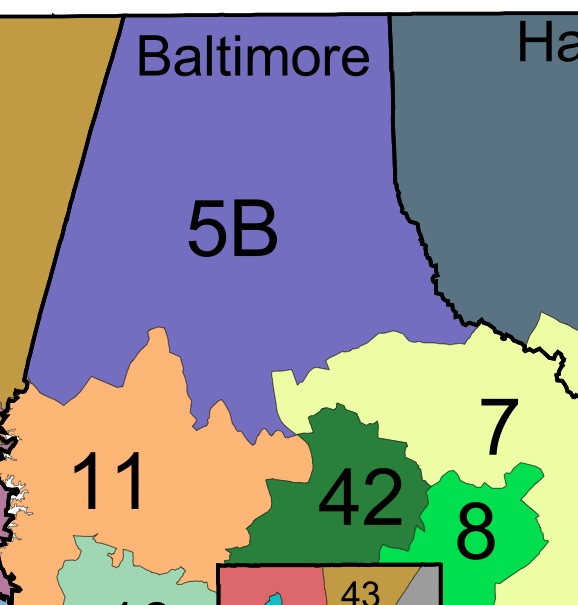
The Old Boundaries of District 42
The new boundaries seemingly take in many new Republican voters, adding red territory in the northern part of the County and losing Democratic Pikesville precincts. The new District 42 is split in two with District 42B (two delegates) a GOP bastion and District 42A (one delegate) safe for the Democrats. The map below helps capture the partisan complexion of the area with bluer areas more Democratic and red areas more Republican (from Dave’s Redistricting). 
Partisan Complexion of northern Baltimore County
The new plan has been widely cast as an attempt to remove Sen. Jim Brochin from Senate by Governor O’Malley and Senate President Mike Miller. Certainly, there is no love lost by either on Brochin. Though Brochin has supported the Governor on some issues, he vocal opposed him on others. Gov. O’Malley repaid the favor by endorsing his primary opponent, former Del. Connie DeJuliis. Maryland Reporter quotes an unusually restrained Mike Miller as playing it cool:
Miller said Brochin has not asked him for help in the race. “It’s very rare that I get involved in a Democratic primary,” said Miller, who has used a Senate PAC to funnel money to help Democratic incumbents get reelected.
“I wish them both well in the primary,” he said.
Miller is famously blunt when he wants to be–reporters surely bless him daily. But Miller’s lack of support for Brochin is unusual for Miller. He is fiercely protective of his caucus and normally backs them to the hilt in primary as well as general elections. The absence of Miller’s support speaks volumes. Brochin casts himself as the most independent and bipartisan member of the Senate. Some might assume that the new lines are punishment for failure to toe the liberal line. Certainly, the unions have joined O’Malley in lining up behind DeJuliis.
Politics is a team sport and Brochin’s independence can cost him friends. His support for marriage equality thrilled Equality Maryland but his vote against trans equality in the last session had the opposite effect. Picking a side can build allies. But lots of members of the legislature stray while remaining in the good graces of colleagues.
Members of the Democratic leadership are often quite understanding of legislators who cannot support them on a tough vote. Del. David Rudolph is extremely well-liked yet one of the most conservative Democrats in the House. Brochin’s problems lie not so much in his conservatism as his unpredictability. He likes to keep people guessing and changes sides frequently–characteristics that frustrate colleagues who value knowing where you stand, at least privately, with some regularity.
While the intent to hurt Brochin seems clear, and Brochin hated the new district lines enough to sue unsuccessfully over them, it is a bit murkier to me. As much as O’Malley and Miller might be happy to toast Brochin’s departure, neither wants to lose a Democratic seat.
The evidence that the new district is drastically less safer for Democrats is pretty thin on the ground. The old district elected two Republican delegates, though Brochin managed a comfortable if not overwhelming 58% in 2010.
In the Senate race for the new district, the Democrats are also looking good. The one Republican in the race has $7K in his campaign account–Bob Ehrlich’s endorsement hasn’t exactly raked in the cash. Looks like a far more exciting battle for the Democratic nomination between Brochin and DeJuliis.
In the fundraising battle, Brochin has $229K in the bank compared to just $42K for DeJuliis. But she can raise money during the session while Brochin cannot. On the other hand, various interests might not want to cross him during the session.
Money is not everything and DeJuliis could well be on her way to having enough funds to be competitive. Her union backing could give her a wealth of volunteers. However, DeJuliis won her sole delegate election in 1990, so this is not the same as the classic delegate-senator matchups elsewhere.
DeJuliis narrowly last the primary for the 2nd Congressional District with 35% in 1994. She received the nomination in 1996 but got badly beat by Bob Ehrlich. All of which is ancient electoral history at this point. Brochin looks well positioned to win both the primary and the general. Still, even if Brochin wins, O’Malley and Miller sure have made him sweat.
On the House side, Del. Stephen Lafferty can breather easier in cozily Democratic 42A with $86K in his campaign account. Del. Susan Aumann ($63K available) looks ready to coast to reelection in Republican 42B with others battling it out for the second GOP nomination. So far, only one Democrat has even bothered to file in the two seat subdistrict.
Surprisingly Dull in D39
None of the four incumbent Democrats that represent District 39 in the General Assembly face opposition–a surprising change from four years ago and not what many expected.
Sen. Nancy King faced fierce competition from Del. Saqib Ali in 2010. Not too long after the 2006 election, Sen. P.J. Hogan stepped down and the MCDCC chose then Del. King, who had won two terms and also served on the Board of Education, for the seat over newly elected Del. Ali.
Ali dogged King relentlessly for the rest of the term, continually attacking her as insufficiently progressive. The 2010 primary was rough with Sleepy Saqib pictures that Ali had posted on his Facebook page appearing in King’s mailers. (Kids, there is a life lesson here.) Ali ran a very strong campaign but The Rumble in Germantown ended with King taking the nomination by 248 votes.
The new redistricting plan just happened to draw Ali’s home into District 15. Unlike for congressional elections, Article III, Section 3 of the Maryland Constitution requires that legislative candidates live in their district. In the words of the Church Lady (late 1980s SNL youngsters), “how convenient.”
But not so surprising. Senate President Mike Miller has zero desire to see Saqib in the Senate. And Ali’s aggressive style in the General Assembly did not win him friends among his colleagues, though it was nearly enough to propel him into the Senate.
Ali could have established residency in the new D39 but committed to D15 when he sought the delegate vacancy last year caused by Del. Brian Feldman’s appointment to the Senate. Ali entered the delegate election in D15 but pulled out in December.
King and Del. Charles Barkley have especially robust campaign accounts–Barkley has 92K compared to 91K for King. Del. Kirill Reznik has a healthy 43K with 26K in Del. Shane Robinson’s account. I guess Reznik needs to serve more expensive hamburgers at his annual Grill with Kirill event. Or maybe Del. Barkley can take him to school.
An enjoyable election season for the incumbents in District 39–but not for those watching elections.
Pro-Gun Challenger in D14 Going Nowhere
In District 14, Sen. Karen Montgomery is currently unopposed for a second term. Sen. Montgomery served two terms in the House of Delegates before knocking out incumbent Sen. Rona Kramer in one of 2010’s top-tier Democratic primaries.
On the House side, Dels. Eric Luedtke and Craig Zucker are also seeking second terms, while senior delegation member Del. Anne Kaiser is running for a fourth term. The four incumbents in the General Assembly are hanging together and have formed a slate that will campaign and do coordinated mailings.
The House incumbents face one challenger, John Paul Evans of Gaithersburg, a 24 year old graduate of Damascus High School . He explained why he was running in a Gazette profile:
The issues that most concern him are civil rights and government transparency.
“I don’t think we have enough transparency in the slightest,” he said.
Evans said he is reluctant to single out one civil right to focus on.
“We’ve had the gun issue, with assault weapons, and we’ve had issues with the [National Security Agency],” he said.
Evans said gun laws should be based on guns’ functionality, not whether they look like assault weapons.
Those topics have been “a driving force” behind his decision to announce his candidacy, he said.
Evans’ oblique campaign announcement further refers to pro-gun and anti-NSA surveillance stance:
I think our government is not treating our civil rights with the respect they deserve. It’s time someone “stands his ground” to solemnly defend our civil rights. I want to do my part to protect our inalienable rights. I want to be there on the ground floor to say, “No, we cannot violate the people like that”, before a bill ever becomes a law. I want to be the first line of defense and give our community a strong and active voice.
“Stands his ground” sounds more like George Zimmerman than John Lewis. In the Sentinel, Evans made more explicit his opposition to Maryland’s new gun laws on Second Amendment grounds. A member of the Snowden generation, it will be interesting to hear more about how Evans plans to rein in the NSA from Annapolis.
The delegates are comparatively well positioned financially if not incredibly flush based on their last pre-session bank balances with Del. Kaiser at $36K, Del. Luedtke at $26K, Del. Zucker at $42K. Sen. Montgomery has $43K (error corrected from previous version).
Free Citizens for John Evans filed an affidavit attesting the he “does not intend to receive contributions or make expenditures in the cumulative amount of $1000 or more.” (Information gathered from the most recent 2014 reports in the Maryland Campaign Finance Database.)
All four incumbents are solid liberals and I’d be shocked if they did not collect the usual round of endorsements from unions and progressive groups. Evans seems most likely to gain support from Free State DINOs, a group encouraging Republicans to register to vote in Democratic primaries to unseat incumbents like Montgomery, Kaiser, Luedtke, and Zucker for supporting the gun laws adopted by Maryland in the wake of Newtown shootings.
John Paul Evans is a frequent flyer in the Maryland Judicial Database due to traffic offenses but none contributed to an accident. He drove on a suspended license in 2009 at the age of 19. The prosecutors declined to prosecute and did the same when Evans repeated the offense in 2011. In 2012, he plead guilty to driving without proper vehicle plates. Just last year, Evans plead guilty to failure to display his license when demanded by a police officer and still lacking the proper plates. The latter appeared related to continued problems with a suspended license.
These problems strike me as not life disqualifying from public service but it would be nice if they were further in the rear view mirror. Regardless, the easy choice for Democrats is to go with the incumbents. They should win easily in any case but face a more vigorous challenge in the general election. Though District 14 has more Republicans than most Montgomery districts, effective campaigns should assure victory in that race too.
Opening Office Parties on Sunday
Gansler-Ivey is opening its Montgomery field office this Sunday from 1-2pm and is inviting MoCo Dems “for refreshments and a meet-and-greet with the candidates.” Address: 326 N Stonestreet Ave. Ste. A2; Rockville, MD 20850
Brown-Ulman is opening campaign offices in Prince George’s and Howard this Sunday. The Prince George’s opening is at 1:45 and the Howard opening is at 3:15, so I guess you can make it a progressive party (oh, what a terrible pun). Addresses: 10236 Lake Arbor Way,
Mitchellville, MD 20721 and 8865 Stanford Blvd. #117,
Columbia, MD 21045.
The Mini Munis of Chevy Chase
Chevy Chase, Maryland Zip Code
Even people who live in Chevy Chase get confused about all of the mini municipalities in the area. I’ve had people think I represent them, though they don’t live in my town. Here is a short guide for the perplexed.
The Chevy Chase, Maryland zip code includes all of the area in the above map. Many portions of the zip code are not part of any incorporated municipality. Much like Bethesda, these areas are a postal address and unincorporated parts of Montgomery County. Some of the western parts of Chevy Chase bleed into Bethesda and the northern parts into Kensington. When I moved back to Maryland and went to get a driver’s license, MVA refused to accept a document with “Bethesda” as the city because my other proofs of residence said “Chevy Chase.”
The Town of Chevy Chase
The Town of Chevy Chase started out as Section 4 but became the Town after it annexed Section 8 in 1976. The Town is the more or less the area between Wisconsin and Connecticut Aves. and between East-West Hwy. and Bradley La. with the commercial area on Wisconsin excluded. The largest incorporated municipality bearing the name of Chevy Chase, it has slightly more than 1000 homes and 2,800 residents and is mostly within walking distance of Bethesda. Many of the homes, particularly those located closest to Bethesda, have been redeveloped, leading the Town to adopt its building code around six years ago. (I have served on the Town Council since 2008, including two years as the Town’s mayor.)
Chevy Chase Elementary School, the Jane E. Lawton Community Center, and the National 4-H Conference Center are also located in the Town. The Town Council operated out of the 4-H prior to the construction of the Town Hall. The Town’s annual Fourth of July picnic is its most popular event.
Town services include back door twice-a-week garbage collection as well as recycling. Over 20 percent of Town residents participate in the Town’s recently established organic recycling program operated by Compost Crew. This week, the most popular town service is that we shovel the sidewalks when more than three inches of snow falls in addition to clearing the streets.
Chevy Chase Village
Chevy Chase Village is larger in area but smaller in population than the Town with just under 2000 people because its homes are mostly on bigger lots. The wealthiest municipality in Maryland, the Village has its own police department located in the Town Hall. It also has a post office located in the Village Hall. The southwestern portion of the Village is very close to Friendship Heights.
Straddling Connecticut Ave., the Village is perhaps best known these days for its speed cameras. The Village loves the cameras because they slow down traffic and generate revenue. Others are perhaps less keen. I once heard traffic along this stretch of Connecticut described as “the funeral procession.” I like to tease Village Board of Managers Chair Pat Baptiste that I try not to walk too quickly in the Village to avoid getting (another) ticket. Pat is extremely experienced in Village and County politics, having served as Chair in the past as well as on the County Planning Board.
President Obama paid a visit to George Will’s home in the Village before his inauguration in 2008 but it appears that the friendship didn’t blossom based on his columns. As the Village not only votes heavily Democratic, like most of Chevy Chase, but supported him strongly in the 2008 Maryland presidential primary, President Obama nonetheless probably feels welcome.
Section 3 of the Village of Chevy Chase
Incorporated in 1982, the Section 3 of the Village of Chevy Chase Section 3 is home to 760 people who live on 280 lots north of Bradley La. and between Connecticut Ave. and Brookeville Rd. Andy Harney is not just a neighbor but the longtime Town Manager. Smart, direct, and tough, she’s great at standing up for her town’s interests, as anyone who has ever seen her in action knows.
Village of Chevy Chase Section 5
Located just north of slightly larger Section 3, the Village of Chevy Chase Section 5 is the more southern of the two “sections” and home to 650 people. It has 223 homes and one restaurant, La Ferme. Like its southern neighbor, it incorporated in 1982.
Martin’s Additions
The Village of Martin’s Additions incorporated a little later than the two sections, its western neighbors, in 1985 and has 933 residents according to the 2010 Census. Like the two sections, its narrow streets make it tricky to navigate but also are why it’s so cute.
Friendship Heights
A triangle located between Willard and Wisconsin Ave., the Village of Friendship Heights is really a special tax district rather than a municipality. The 2010 Census reported that 4,700 people live in Friendship Heights. Unlike the municipalities described here, Friendship Heights is characterized by apartment and office buildings rather than single-family homes. The Shuttle Bus service to the Metro and the Giant is very popular.
Somerset
Halfway between Friendship Heights and Bethesda between Wisconsin Ave. and Little Falls Pkwy., the Town of Somerset has 1,200 residents. Mayor Jeffrey Slavin, who been mayor since 2008 and served on the Council previously, governs from the most attractive town hall in Chevy Chase. The Town Hall is located next to the popular Town Pool, which Somerset worked hard to renovate.
Village of Drummond
How small is Drummond? It’s too small for the Census Bureau to reveal its population. Another special tax district, Drummond is just two-thirds of one street with 43 homes. Nevertheless, the tax district is older than many of the municipalities, having been established in 1916. You’ll see Drummond just north of Somerset if you’re walking down Wisconsin Ave.
North Chevy Chase
Home to 519 people living in around 200 homes, North Chevy Chase is just south of the Beltway in the northeast quadrant of the intersection of Jones Bridge Rd. and Connecticut Ave.
Chevy Chase View
Perhaps a tad more conservative than most of liberal Chevy Chase, Chevy Chase View is just south of Kensington and is part of the greater Kensington metro area. Although the area has a long history, Chevy Chase View incorporated only in 1993. It has 920 residents.
Kensington and Garrett Park
The most excellent Towns of Kensington and Garrett Park are also considered by many to be part of Chevy Chase, though outside the zip code and with their own postal addresses. Unlike the other towns, Kensington has a commercial district. Mayor Pete Fosselman has served since 2006 and overseen the adoption of a new plan for the town. Del. Al Carr was on the Kensington Town Council before being entering the legislature. County Councilmember Nancy Floreen served as Garrett Park’s mayor before moving on to Rockville.
I’m just too tired to write more but go check out Antique Row in Kensington and Black’s Market in Garrett Park.
Chevy Chase Town Council Meeting
In addition to writing this blog, I am one of the five members of the Town of Chevy Chase’s Town Council and the current Town Treasurer. The following is an unofficial summary of our meeting last Wednesday.
Executive Session
The Town Council met in closed session from 5:30-7pm to discuss (1) potential litigation as it relates to the Purple Line, (2) an Open Meetings Act complaint, and (3) a Maryland Public Information Act (MPIA) request.
Purple Line
Mayor Pat Burda made remarks on the Town’s actions regarding the Purple Line. Here is part of her statement:
I was quoted in the Washington Post as saying “the Town is not lobbying Congress.” The statement, which I attempted to clarify before it reached the printed Sunday Post, referred specifically to an inquiry about lobbying the Chairman of the House Transportation and Infrastructure Committee. I also said that it would be foolish to try to lobby Congress to defund the project given Senator Mikulski’s position as Chairwoman of the Senate Appropriations Committee.
To fully set the record straight, the Town is speaking to Members of Congress to raise the same concerns we raised with the Maryland Transportation Administration about the proposed Purple Line project. It is our hope that through this effort of educating decision makers about the currently proposed Purple Line, that the Federal Transit Authority (FTA) will carefully consider all of the facts before them.
The Council was not ready to take action at this meeting, but plans on holding a special meeting next week at which it may take action. This meeting will be announced in advance and open to the public. All members of the Council thanked the Mayor for the incredible amount of time she has spent and hard work she has done on this issue.
Undergrounding Utilities—PEPCO Preliminary Cost Estimate
The Town received a letter from PEPCO dated February 6 which gave their preliminary estimate to bury the power lines in the town as:
$50 million, not including undergrounding telecommunication lines, any upgrade work required by the customer, or installation of new street lights. Costs incurred by each customer would range from $5000 to $15,000 for meter box upgrades, burying services wires and internal electrical upgrades, if needed.
PEPCO has promised to provide a more detailed cost per mile estimate to the Town within two weeks that:
will consider actual Town street mileage of 9.94 miles (versus 10 miles) as well as physical conditions in the field, including Town street width, as it impacts excavation around other utilities and traffic control, and the number and location of existing public and private trees and landscaping.
PEPCO will also provide a price quote on the cost to the Town for PEPCO:
to perform a one line schematic and conduit schematic and conduit schematic in order to further refine the ‘costs per mile’ estimate.
The letter also reaffirmed that PEPCO will not help to pay for undergrounding the Town’s power lines:
As PEPCO officials indicated at the Town’s public meeting on December 5, 2013, the Town would be responsible for all costs associated with undergrounding electrical lines in the Town.
New Power Reliability Task Force
As we continue to explore the cost and benefits of undergrounding power lines, the Town needs to consider other options designed to address the very real concerns and frustrations of Town residents with the reliability of power service in the Town.
During the course of meetings on this topic, a number of residents with real knowledge and expertise on this topic offered innovative or alternative ideas. For example, some suggested that we should explore getting PEPCO to improve the robustness of the network by making it possible to shift electricity from one feeder to another when the power goes out. Another has suggested that the Town create a town-wide micro grid using large-scale fuel cells.
As a result, I proposed that the Mayor appoint a Task Force of residents to explore alternative reliability strategies. The Task Force could work with PEPCO and also make a proposal to the Town Council for outside expertise that would enable them to conduct their work more effectively. I was pleased that the Town Council approved the proposal unanimously.
I encourage anyone interested in participating in the Task Force to email the Mayor at townoffice@townofchevychase.org along with information about the expertise that you would bring to the Task Force.
Town Election Procedures
The Town Council voted 4-1 (with Councilmember Bickerman voting against) to adopt the Staff Proposal for the conduct of runoff Town elections in the event of tie. The runoff elections would occur in a similar manner to regular elections. Residents would be notified of the runoff via postcard and other Town communication methods. Over a 20-day period, residents could go vote in the Town Office or request a ballot via email which would be delivered to their home.
The Town Council decided 4-1 (with Councilmember Strom voting against) to not notify residents in the Forecast which incumbents will file to seek reelection.
Despite the division on the votes, most members of the Council did not feel especially strongly about either issue and were happy to reach a reasonable conclusion on both matters.
Meadow Lane Preliminary Landscaping Plan
The Council reviewed the preliminary plan for the public right-of-way along the former Li property on Meadow Lane. The Council agreed 4-0 (with Councilmember Bickerman abstaining) to move forward with the proposal. Councilmember Al Lang expressed that he felt it important to proceed with taking care of this matter and enhancing the pedestrian walkway and the right of way, as a plan along these lines was part of the promise by the Town to residents when the property was subdivided. The Council also expressed to the neighboring resident who attended the meeting that we would be happy to work with her on the nature of the plantings adjoining her property. The proposal is not designed or intended to facilitate public use of the private properties adjacent to the public right-of-way. If anything, the plan should have the opposite effect.
Early Adjournment
After quickly approving the minutes and the financial report, the Council adjourned at 8:30 as snow had already begun to fall.


